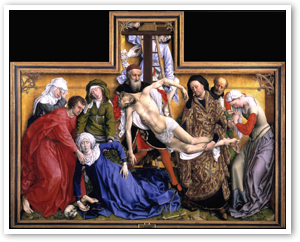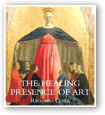'Rogier van der Weyden's Review: Intensity in Life and Death
- RICHARD CORK
The religious paintings of Rogier van der Weyden are full of emotional power, ranging from the tenderness of a mother's love to the intensity of Jesus' death.
 For many years, visitors to the Prado Museum have been confronted by the overwhelming impact of "The Descent From the Cross" (c. 1435), a monumental painting filled with the anguish of witnessing Christ's death. And now, the artist who created it has become the focus of a special exhibition at the Prado that also contains many major loans from other collections. His name is Rogier van der Weyden, and the range of work brought together here reveals an impressive eloquence. Born in Tournai in present-day Belgium about 1399, he subsequently moved to Brussels and became the city's official painter before dying there in 1464. The only other Flemish artist of that period who equals him is Jan van Eyck, and both artists used the new medium of oil painting on panel with dazzling realism. But this Prado survey, which celebrates the museum's successful restoration of a late painting called "The Crucifixion," commands an emotional power that distinguishes Van der Weyden throughout his career.
For many years, visitors to the Prado Museum have been confronted by the overwhelming impact of "The Descent From the Cross" (c. 1435), a monumental painting filled with the anguish of witnessing Christ's death. And now, the artist who created it has become the focus of a special exhibition at the Prado that also contains many major loans from other collections. His name is Rogier van der Weyden, and the range of work brought together here reveals an impressive eloquence. Born in Tournai in present-day Belgium about 1399, he subsequently moved to Brussels and became the city's official painter before dying there in 1464. The only other Flemish artist of that period who equals him is Jan van Eyck, and both artists used the new medium of oil painting on panel with dazzling realism. But this Prado survey, which celebrates the museum's successful restoration of a late painting called "The Crucifixion," commands an emotional power that distinguishes Van der Weyden throughout his career.
Not all his paintings are harrowing. One of the earliest works on display is the Prado's own gentle panel of 1435-38 showing "The Virgin and Child," also known as the "Duran Virgin." Mary is shown seated in a niche, like a sculpture projecting from the wall of a church. Above her hovers a small angel, tenderly holding an elaborate crown over the Virgin's head. Like everything in Van der Weyden's oeuvre, the crown is depicted with an astonishing grasp of realism. It became the hallmark of his radical art, and yet he attached even more importance to conveying the most heartfelt feelings in the figures who inhabit his paintings.
The Virgin looks down, and one tender hand grasps the weighty book resting on her lap. But her other hand protectively clasps her son's body, and he is far removed from the distant, formal solemnity dominating so many medieval depictions of the Christ child. This eager little boy twists around and seizes several of the book's pages, crumpling one of them as he struggles to find out what it contains. Van der Weyden imagines just how entranced the child would have been by the discovery of literature, and this delightful little painting conveys the boy's total absorption in his task.
Compared with the simplicity of "The Virgin and Child," the large altarpiece "Triptych of the Seven Sacraments," painted about 1450, shows an extraordinary amount of momentous activity occurring within one church. The main panel is dominated by a crucifixion, where Christ dies high up near the vaulted ceiling of a lofty nave. Behind him, the Eucharist is being celebrated. But the most affecting sacraments occur in the side panels. On the left, a baby is being baptized and a praying boy confirmed, while beyond them a kneeling man confesses. Van der Weyden depicts all three of these sacramental activities with poignant conviction, and in the right panel a very moving juxtaposition places ordination and marriage remarkably close to the extreme unction of an emaciated man dying in bed. Angels float above him, gesturing and clasping scrolls with Latin inscriptions. But Van der Weyden is not afraid to emphasize the extreme harshness of death, as the bedridden patient stretches out his skeletal arm to be anointed with holy oil.
This devastating panel is filled with Van der Weyden's uncompromising determination to make viewers share the grief experienced by the men and women gathered around Christ's blanched, lifeless body.
Even so, nothing can prepare us for the sheer visceral agony of "The Descent From the Cross." This devastating panel is filled with Van der Weyden's uncompromising determination to make viewers share the grief experienced by the men and women gathered around Christ's blanched, lifeless body. He is being lowered with immense care from a surprisingly small cross. And the figures surrounding him are all crammed into a claustrophobic space that almost imprisons them. On the far right, the Magdalen appears to imagine that she has been hit by a body-blow. She staggers, clutching her fingers and projecting both elbows. Van der Weyden, whose handling of drapery is always expressive, makes sure that the dramatic creases in her dress reinforce the anguish she suffers. And the inconsolable Nicodemus next to her weeps glistening tears as he holds Christ's slender, elongated legs.
The white-bearded Joseph of Arimathea, who supports the rest of the corpse by placing his hands under Christ's armpits, looks more stoical. But Van der Weyden insists on painting with painful immediacy the blood issuing from Christ's head and torso. As for the gash in his right hand, it makes us flinch as we scrutinize this deep cavity painted with such clinical precision. Moreover, Van der Weyden places the wound uncomfortably near the Virgin's dangling left hand. She has fainted, and her bleached face appears close to death as she tumbles sideways. Her other hand rests on the ground, yet there is no escape even there: A skull lurks nearby, its teeth and empty eye-sockets defined with alarming clarity. No wonder St. John weeps as he rushes forward to support the disconsolate Virgin. Frowning, distraught and exhausted, he looks almost traumatized.
St. John reappears in "The Crucifixion," an elegiac late painting executed about 1457-64 and subsequently damaged by fire. This immense panel, after a prolonged bout of restoration, has now emerged as a rediscovered masterpiece. St. John looks up, opening both his hands in sorrow as he contemplates the harrowing reality on the cross. But the Virgin, the only other figure depicted here, cannot gaze any more at her son's demise. She raises white drapery to her face and almost closes both eyes. The Virgin's grief is insupportable, for her legs buckle as she struggles to remain upright. The tension in her body is transmitted with all the incisive conviction that Van der Weyden can muster, and his profound intensity places him among the most outstanding 15th-century artists.
 This is Meaghen Gonzalez, Editor of CERC. I hope you appreciated this piece. We curate these articles especially for believers like you.
This is Meaghen Gonzalez, Editor of CERC. I hope you appreciated this piece. We curate these articles especially for believers like you.
Please show your appreciation by making a $3 donation. CERC is entirely reader supported.

Acknowledgement
 Richard Cork. "'Rogier van der Weyden' Review: Intensity in Life and Death." The Wall Street Journal (June 1, 2015).
Richard Cork. "'Rogier van der Weyden' Review: Intensity in Life and Death." The Wall Street Journal (June 1, 2015).
Reprinted with permission of the author and The Wall Street Journal © 2015 Dow Jones & Company, Inc. All rights reserved.
The Author

 Richard Cork is a British art historian, editor, critic, broadcaster and exhibition curator. He has been an art critic for the Evening Standard, The Listener, The Times and the New Statesman. He was Slade Professor of Fine Art at Cambridge from 1980–90, and the Henry Moore Senior Fellow at the Courtauld Institute of Art in London from 1992–95. He then served as Chair of the Visual Arts Panel at the Arts Council of England until 1998. Among his many books he is the author of Face To Face: Interviews with Artists and The Healing Presence of Art: A History of Western Art in Hospitals.
Richard Cork is a British art historian, editor, critic, broadcaster and exhibition curator. He has been an art critic for the Evening Standard, The Listener, The Times and the New Statesman. He was Slade Professor of Fine Art at Cambridge from 1980–90, and the Henry Moore Senior Fellow at the Courtauld Institute of Art in London from 1992–95. He then served as Chair of the Visual Arts Panel at the Arts Council of England until 1998. Among his many books he is the author of Face To Face: Interviews with Artists and The Healing Presence of Art: A History of Western Art in Hospitals.




